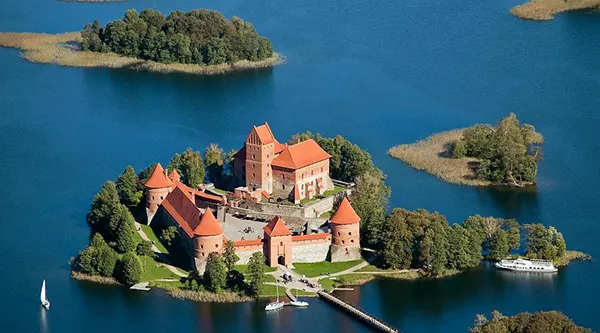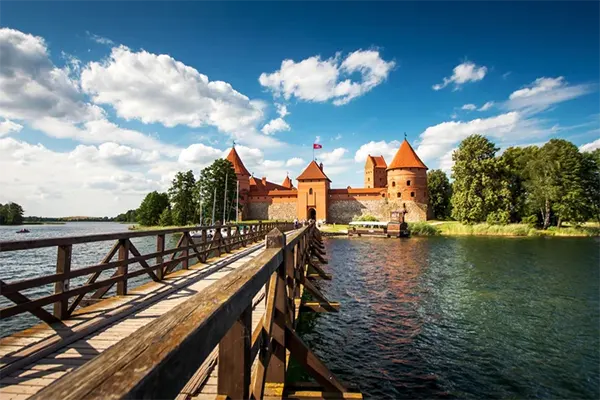
Trakai Island Castle – A Medieval Jewel in Lithuania
Trakai Island Castle is one of Lithuania’s most iconic historical monuments, located on an island in Lake Galvė. This red-brick fortress stands as a rare surviving example of Gothic architecture in Eastern Europe, attracting thousands of visitors every month. Its unique location, centuries-old history, and cultural significance make it a destination of great interest not only for tourists but also for historians and researchers.
The Historical Background of Trakai Castle
Construction of Trakai Island Castle began in the 14th century under Grand Duke Kęstutis and was completed by his son Vytautas the Great in the early 15th century. It served as a strategic military stronghold, playing a key role in defending the Grand Duchy of Lithuania from crusading Teutonic Knights. The castle also functioned as a political centre where important diplomatic negotiations took place.
Vytautas the Great transformed Trakai into one of the most significant cities of medieval Lithuania. The castle was more than a fortress — it became a princely residence. Its architecture was adapted to reflect both security concerns and the grandeur of a ruling centre. Today, the castle stands as a restored version of its former self, reflecting the pride of Lithuania’s heritage.
Over the centuries, the castle underwent decline and partial destruction, especially during wars in the 17th century. Restoration efforts, initiated in the 20th century and continuing into the 21st, have turned the site into a well-maintained historical museum and cultural venue that showcases life in medieval Lithuania.
Strategic Importance and Cultural Role
Trakai’s position on an island was not chosen by accident — it was a deliberate tactical move. The surrounding waters of Lake Galvė made the castle difficult to besiege and enhanced its defensibility. This natural protection, combined with the robust walls and towers, turned Trakai into one of the most fortified locations of its time.
Aside from its military value, Trakai Castle was an important multicultural hub. It hosted Lithuanian nobility, Karaims, Tatars, Russians, Poles, and Jews, making it a symbol of peaceful cohabitation in a diverse society. This heritage continues to define the cultural atmosphere of modern-day Trakai.
Today, the castle is a focal point for national celebrations and international festivals. It’s a place where Lithuanians reconnect with their roots and where global travellers learn about the nation’s past. Concerts, exhibitions, and educational programs take place in its restored halls and courtyards throughout the year.
Architectural Features and Interior Layout
Trakai Island Castle is a striking example of Gothic architecture. Built using red bricks and large stones, the structure features pointed arches, defensive towers, and a spacious inner courtyard. The castle’s architectural style blends Western European fortification techniques with local adaptations suited to its environment.
The complex consists of three main parts: the outer castle, the inner courtyard, and the ducal palace. The outer sections were used for defensive purposes and to house soldiers, while the palace was a residence for the ruling family. The intricate design reveals how function and aesthetic beauty were balanced during the medieval period.
The castle interiors today serve as exhibition spaces. Visitors can explore historical artefacts, medieval weaponry, reconstructed chambers, and interactive displays. Informational panels are available in multiple languages, ensuring accessibility for international visitors and providing historical insights to all age groups.
Modern Renovations and Museum Status
Systematic restoration of Trakai Island Castle began in the 1950s and continued into the 21st century with EU funding and Lithuanian government support. Architects and historians worked meticulously to rebuild sections using historical documents and archaeological data, resulting in a historically faithful reconstruction.
Since 1962, the castle has functioned as part of the Trakai History Museum. The exhibitions focus on Lithuanian statehood, medieval warfare, and the multicultural heritage of the region. Recent updates include digital exhibits and VR tours, enhancing the learning experience for modern audiences.
In 2025, Trakai continues to receive investments for preservation, with environmental monitoring systems now installed to protect the site from humidity and seasonal damage. This ensures that future generations will also have the opportunity to experience the grandeur of this medieval landmark.

How to Visit Trakai Island Castle Today
Trakai is located approximately 28 kilometres west of Vilnius and is accessible by train, bus, or car. From the town centre, visitors can enjoy a scenic walk across wooden bridges leading to the castle. Entry tickets can be purchased online or at the gate, with discounts available for children, students, and pensioners.
Summer is the peak season for visiting, with the castle open daily from 10:00 to 19:00. Guided tours are available in multiple languages, and cultural events are often scheduled during weekends. For those seeking a deeper experience, night tours and theatrical performances recreate scenes from medieval life inside the castle walls.
Apart from the historical aspect, Trakai offers recreational activities including boat rentals on Lake Galvė, traditional Karaim cuisine in local restaurants, and craft fairs that sell handmade souvenirs. The combination of natural beauty and historical richness makes Trakai an ideal day trip from Vilnius.
Practical Information and Travel Tips
Visitors should wear comfortable footwear, as the castle grounds involve walking on cobblestones and uneven terrain. During summer, booking tickets in advance is recommended to avoid queues. The museum also offers QR-code audio guides for self-paced exploration.
Photography is permitted inside the museum, although drone use requires prior authorisation. Visitors with limited mobility should be aware that some areas remain inaccessible due to the historical nature of the structure, although ramps and handrails have been added where possible.
Trakai is part of the Lithuanian National Heritage Register, and tourism contributes to its upkeep. Travellers are encouraged to respect signage, avoid touching exhibits, and support local artisans. This mindful approach helps ensure the site’s sustainability for years to come.
